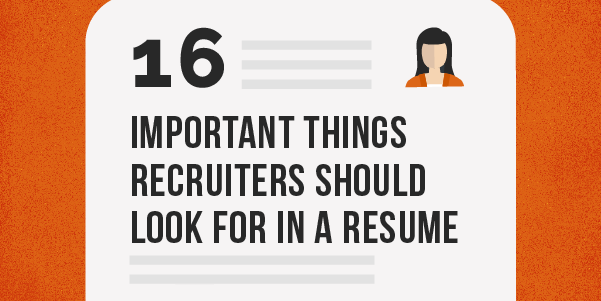In 2000, 22% of resumes were sent through email and posted on various job boards. In 2014, a notable increase of over 90% of resumes was posted online or through email.
This trend proves one thing for all HR managers and business owners—with a vast pool of talents available, together with social media and technology, it’s easier and faster to apply for different jobs. This may seem good for recruitment, but it comes with a precaution. It’s important for HR and recruitment personnel to be more meticulous when it comes to screening resumes and candidates’ profiles.
With numerous applications received each day, it’s going to be a tough business as usual for all HR and recruitment consultants. The screening process is not simple, as it goes way beyond the skills and experience of each potential candidate.
If you’re a part of the HR and recruitment team, you must be able to screen submitted resumes wisely and carefully to avoid risks and issues in the long run. When searching for candidates, take note of these screening details to guide you:
Prepare necessary details
First things first, you have to prepare a handy list of the specific objectives you’re looking for in a candidate. This depends per job position and industry.
Job description – Take note of the specific job description and requirements needed for the position.
Must-have skills –Prepare a list of important skills required for the position. These should be aligned with the job description.
Must-have experience – Make a list of specific and relevant work experience and estimated number of years since some job positions require specific years and work background to pass.
Skills, achievements and work values – Create your list of important skills, achievements, and work values needed for the job position to help you screen quickly and cautiously.
Study the entire resume
Once you have your screening essentials, it’s now time to get to business and thoroughly assess a resume. After a quick screen, by now, you should be down to half of the total number of applications after separating the qualified profiles from the unqualified.
1. Correct spelling and grammar – A resume with no spelling and grammatical errors show that a candidate proofread his application and assures that he is well-versed for the job position he’s applying for.
2. Qualifications – Should contain the applicant’s educational background, work experience, achievements, skills, and competencies. You can get to know the candidate through this section and assess whether he’s suitable for the job.
3. Presentation and formatting – Covers the resume’s overall readability, look, and content, and should be easily understood and detailed. The presentation depends per work industry. If a candidate is applying for a design-related job, it should show on his resume.
4. Industry keywords – When screening resumes, look for applicable keywords to help ease up the process. If you’re screening for marketing jobs, look for the keywords “sales,” “advertising,” and “PR”; for developer jobs, look for “programming,” “coding,” and “website.”
5. Personality and work values – Aside from a candidate’s qualifications, you must also get to know his personality and work ethics. Most job positions require “can work with a team,” “detail-oriented,” and “fast and continuous learner.”
6. Consistency – Resumes can now be viewed and posted on social media and online job sites as an alternative to email. When screening resumes online, you have to take note of the consistency and uniformity of each uploaded resume.
7. Character/professional references – After evaluating the entire resume, the references are your first-hand witnesses to a candidate’s work performance. You can interview and call these people to know the candidate more.
Watch out for the red flags
Since resumes are a candidate’s main entry to the job table, some vital details and information are often modified and overstated to fit the job position more.
8. Lacks professionalism – Typos, sentence errors, unrelated buzzwords, and poor formatting are among a resume’s red flags. You should also observe the resume and attached job-related materials such as cover letters and the portfolio’s tone and language such that it should be honest, direct, and confident.
9. Employment gaps and shifts – Some employees have done job hopping and a noticeable gap between employments. These are common occurrences in the job market and can be considered as normal, but too many job shifts and time lapses can be a red flag that a candidate might not stay for a long time with your company too.
10. Unspecified job objectives – Most of the time, if a resume has no specific objectives, it’s already classified as a red flag. The objective shows a candidate’s interest to the job position, and without it, a candidate may be seen as someone who’s not really up for the job.
Take note of the bonus features
Some resumes tackle more experiences beyond their qualifications, and these candidates usually stand out from the rest.
11. Solved work problems – How a candidate solved problems and his responsibilities in his previous company.
12. Saved time and costs – How a candidate managed to save both time and money in his previous company.
13. Contributed revenue – How a candidate acquired sales and profit for the previous company.
14. Helped people – How a candidate assisted, mentored, and led people on the previous job.
15. Created work – The amount of work a candidate has produced for his previous job.
16. Acquired awards and recognition – How a candidate gained awards and recognition in his previous job.
HR staff and a recruitment consultant can be considered as the front liners of a company since they are responsible for every employee who enters and joins the team, and this all starts with every submitted resume. Screening resumes comes with a great responsibility towards the employer and the applicant, and it’s not an easy feat.
Whether you’re a part of the HR and recruitment team or a business owner, you have to be a great observer of profiles. Behind every applicant is always an impressive resume—some details can be overdone, while some are unfit for the job. It’s your task to deem whether a candidate’s worthy or not, so screen wisely.
SPECIALIST RECRUITMENT SOLUTIONS DELIVERING UNRIVALLED RESULTS
IN THE PHILIPPINES
Manila Recruitment is recognized as the leading recruitment firm in the Philippines for headhunting, executive search, expert, technical and IT recruitment. We share an unrivalled passion to help your business succeed by understanding your goals, then sourcing and providing you with your number one asset – driven, dedicated and exceptional people!
Experience the Manila Recruitment difference, and give your business in the Philippines a competitive advantage by contacting us today. Whether you are exploring an offshore solution, or are an established entrepreneur, SME or Multinational in the Philippines, our team has the experience and a tailored recruitment solution to introduce you to the top talent in the Philippines.
Contact our Manila Recruitment team at hello@manilarecruitment.com.
















